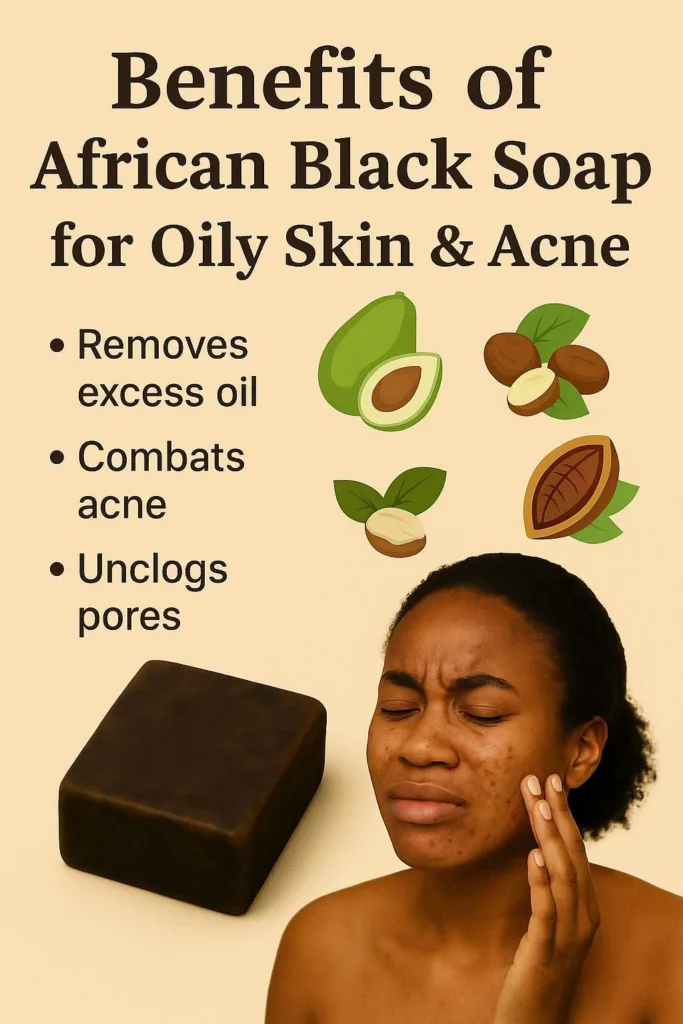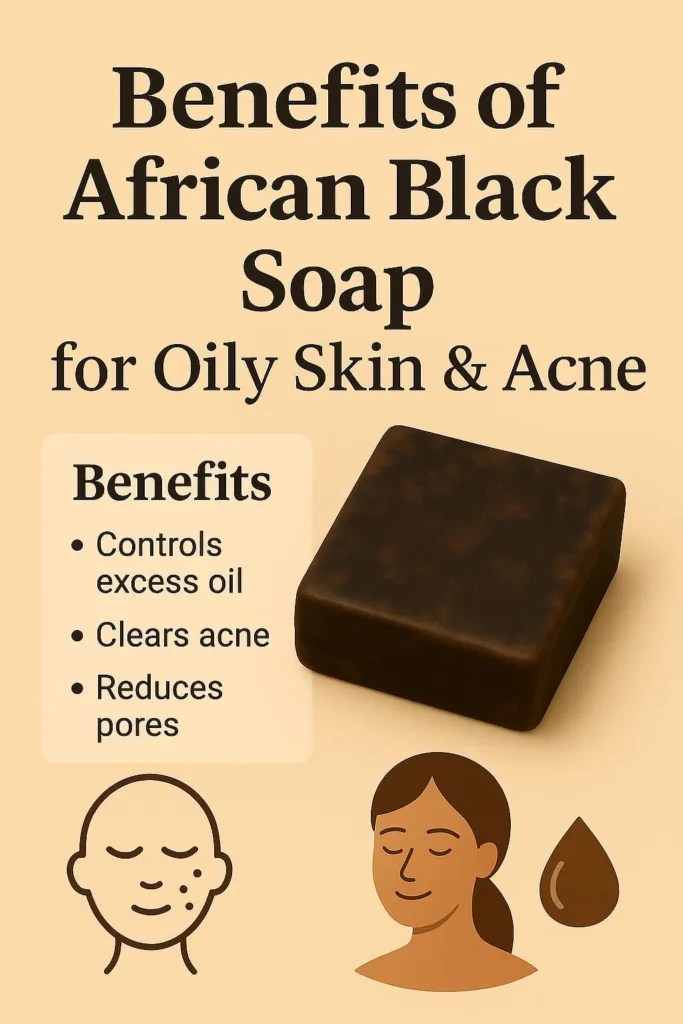What Is “Black Soap,” Really? (Two Products, One Name)
The first time I bought “black soap,” I didn’t realize there were two totally different products sharing the same name. I grabbed what looked like a sleek black bar at the drugstore, expecting the traditional African remedy I’d read about online. What I got instead was a charcoal-infused soap that worked completely differently. Here’s how I finally figured it out.
“Black soap” actually refers to two distinct products:

African black soap (ABS) is the traditional West African soap made from plantain peel ash, cocoa pod ash, and oils like shea butter or palm kernel oil. It’s been used for centuries across Ghana, Nigeria, and other West African regions. This soap has a distinctive brown-black marbled appearance, soft crumbly texture, and earthy scent.
Charcoal “black soap” is a modern creation—regular soap base colored and enhanced with activated charcoal. It’s typically jet-black, firm, and designed to absorb oil and impurities. While effective, it’s fundamentally different from traditional African black soap in both ingredients and benefits.
Understanding this difference is crucial because they work differently on your skin and require different approaches.
Quick Verdict: Who Should/Shouldn’t Use It
Black soap works best for:
- Oily or combination skin types
- Body acne and razor bumps
- Those who prefer a squeaky-clean feeling
- People dealing with excess oil production
Proceed carefully if you have:
- Dry or sensitive skin
- Eczema, rosacea, or compromised skin barrier
- Very reactive skin that stings easily
When my skin barrier felt tight and irritated, black soap went from skincare hero to harsh villain—until I completely changed how I used it. The key was treating it as a treatment, not a daily cleanser.
Benefits (With Evidence-Backed Claims)
African Black Soap Benefits: The plantain and cocoa pod ash provide gentle natural exfoliation, helping remove dead skin cells without harsh scrubbing. The high potassium content helps remove excess oil effectively, making it particularly useful for oily skin types. Many users report improvements in body acne and ingrown hairs, likely due to its clarifying properties and gentle exfoliation.
Charcoal Soap Benefits: Activated charcoal acts like a magnet for oil and impurities, making it excellent for post-workout cleansing. It can help reduce the appearance of pores temporarily by removing buildup and excess sebum.
On humid summer days, two minutes with black soap prevents that midday slick on my T-zone that used to drive me crazy. However, I learned to balance this benefit with proper hydration afterward.
Side Effects & Who Should Avoid It
I learned the hard way that “natural” doesn’t mean “irritation-proof.” Patch testing saved me from a full-face disaster the second time I tried black soap.
Potential issues include:
- Dryness and skin tightness
- Stinging sensation, especially around sensitive areas
- Over-exfoliation if used too frequently
- pH imbalance—black soap can be more alkaline than your skin’s natural pH of around 5.5
Always patch test on your inner arm or behind your ear before using on your face. Wait 24 hours to check for reactions. Avoid using on open wounds, active breakouts, or compromised skin.
People with eczema, rosacea, or very sensitive skin should consult a dermatologist before incorporating black soap into their routine.
How to Use Black Soap (Face & Body, Step-by-Step)
The game-changer for me was treating black soap like a treatment, not an everyday face wash. Here’s what actually works:
For Face (2-3 times per week maximum):
- Wet your hands and the soap—never rub the raw block directly on your face
- Create lather in your hands until you have a creamy foam
- Gently massage onto damp skin for 20-30 seconds, avoiding the delicate eye area
- Rinse thoroughly with lukewarm water
- Immediately follow up with a hydrating toner or serum, then moisturizer

For Body: Black soap shines as a second cleanse for back and chest acne. Use a shower pouf or washcloth to create lather, then apply to problem areas. The body can typically handle more frequent use than the face.
Critical aftercare: Look for products containing glycerin, panthenol, hyaluronic acid, or ceramides to replenish moisture and restore your skin barrier.
African Black Soap vs Charcoal Black Soap (Key Differences)
Ingredients:
- ABS: Plant ash + natural oils (shea butter, palm kernel oil, coconut oil)
- Charcoal soap: Standard soap base + activated charcoal + synthetic ingredients
Texture and appearance:
- ABS: Soft, crumbly, brown-black marbled with visible variations
- Charcoal soap: Firm, uniform jet-black color
Storage considerations: My sink used to look like a watercolor disaster until I switched to a proper draining soap dish. African black soap melts faster and needs good drainage. Charcoal soap is more stable but still benefits from dry storage.
How to Spot Authentic African Black Soap
If it looks like a polished obsidian stone, it’s probably not the traditional stuff. Here’s what to look for:
Visual cues:
- Brown-black marbled appearance with natural variations
- Uneven, handmade appearance
- Soft, slightly crumbly texture
- Smoky, earthy scent (not overpowering or artificial)
Label ingredients:
- Mentions plantain peel ash or cocoa pod ash
- Lists shea butter or palm kernel oil
- References small-batch production
- Sourcing from Ghana, Nigeria, or other West African regions
Red flags:
- Perfectly uniform jet-black color
- Glassy, polished appearance
- Generic “black soap” labels without specific ingredients
- Made in facilities that clearly aren’t following traditional methods
Pairing & Routine Builder (What to Use With/After)
Black soap pairs well with:
- Niacinamide serums (help control oil production)
- Panthenol or glycerin-based toners (restore hydration)
- Light gel moisturizers (won’t clog pores)
- Gentle cleansers on off-days
Avoid combining the same night with:
- Strong acids (AHA, BHA, vitamin C)
- Retinoids or retinol products
- Benzoyl peroxide (for sensitive users)
I keep retinoid nights and black-soap nights completely separate—my skin thanks me for this schedule. Monday and Thursday are my black soap nights, while I use retinol on Saturday nights only.
Real-Life Notes: Personal Experiences & Takeaways
Your cheeks and forehead are different neighborhoods—treat them that way. Here’s what I’ve learned through trial and error:
Oily T-zone experience: Black soap works beautifully as an AM cleanse during summer months when oil production peaks. However, it’s too stripping during winter when my skin needs more moisture retention.
Body acne results: I noticed a significant decline in chest and back breakouts after incorporating black soap into my post-workout routine. The key was using it immediately after sweating, not hours later.
Sensitive cheek area: My cheeks can only handle black soap 1-2 times per week, followed immediately by a thick, barrier-repairing moisturizer. More frequent use led to redness and flaking.
Seasonal adjustments: Summer humidity calls for more frequent use (every other day), while winter requires scaling back to twice weekly maximum.

Key Takeaways
Black soap isn’t a one-size-fits-all solution, despite its growing popularity. Success depends on choosing the right type for your needs, using proper technique, and adjusting frequency based on your skin’s response.
Start slowly—many people jump in with daily use and end up with irritated, over-stripped skin. Pay attention to how your skin feels 2-4 hours after use. Tight, uncomfortable skin means you need to reduce frequency or improve your aftercare routine.
Most importantly, remember that skincare is highly individual. What works for your friend’s oily skin might be too harsh for your combination skin. Listen to your skin, adjust accordingly, and don’t be afraid to take breaks if irritation occurs.
The best skincare routine is one you can maintain consistently without compromising your skin barrier. Black soap can be an excellent tool in that routine—when used thoughtfully and with proper respect for its potency.